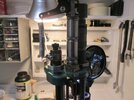I'm seriously trying to understand why it won't just work. I got about 20 rounds loaded in about 2 hours. The priming system is doing weird things again.
Disclaimer: Since we don't know what you did to the SPP/Pro 6000 kit during 5-6 hours, we will try to pick up from post #31
The priming system is doing weird things again ... The flat plastic slider piece that the metal primer piece connects to is randomly hanging up in the track. I bent the end down a bit so it doesn't snag on the track guide piece. That's the second time I have done that and now it appears to be working again for now.
What "weird things"?
Primer slider can hang in the "track" or channel/trough due to number of reasons:
- Spring end hitting the 4 hold down tabs (Your press should have shipped with updated spring with small ends but you can check if spring end is hitting the 4 hold down tabs as slider moves back and forth)
- Debri in the "track" or channel/trough (Likely powder granules. Primer slider channel/trough is designed to be self-cleaning with cleaning holes along the edge of "track" and in the center. Back and forth movement of slider should drop debri through these holes but if you see debri that's not clearing, you can remove it by hand or blow it off the channel/trough (You can even remove the slider completely to clean the channel/trough but note that there's a protrusion towards the end that you need to lift the slider over)
- Primer guide that attaches to the end of slider needs to be installed flat with the slider and opening facing towards the primer attachment (Check the end of slider to ensure opening/fingers are not bent/damaged which will hinder smooth sliding of slider)
- Before primer guide enters station #2, check to ensure top of priming pin/rod dropped down slightly below surface or primer guide could bump up and not enter the station fully (If not, your carrier cover should be updated self-cleaning and simply push up on the priming pin/rod from bottom a few times until debri/powder granules clear from sleeve hole and top of priming pin/rod drops down slightly below flush)
- If shellplate is not tight (I mentioned this in the "Best Practices ..."), could prevent primer guide from entering station fully.
- Bent spring could hinder smooth sliding motion of slider by bending and if you cannot return the spring back straight, it needs to be replaced.
- Slider must be flat and straight. If not, could bind in the channel/trough. If plastic "memory" won't stay flat and straight, slider may need to be replaced.
So check your press/priming system as outlined above to identify the source of your slider "hanging".
Second problem is the primers seem to appear to being seated and the upstroke doesn't have a primer in the primer arm like I would expect if it working properly but the it's actually losing the primer but getting jammed up under the shell plate.
Once again, we don't know what happened up to this point but will go from here with some "assumptions".
Priming system should pick up a primer from the attachment and insert into station #2 but if not seated into a case, primer guide should pull it back and hold the primer and slide back and forth until primer is seated into a case.
First, check to ensure shellplate is not loose (If you spilled any powder or lost primer under the shellplate, I would remove the shellplate and inspect the carrier cover and clean as necessary).
Then check to ensure priming pin/rod is dropping slightly below surface (Priming pin/rod not dropping could prevent primer guide from entering station freely and could tip up guide from slider end and cause primer to flip/go sideways to jam under the shellplate).
Then cycle the ram lever while watching the primer slider/guide/primer to ensure they are sliding smoothly and entering station #2 fully.
my confidence level has dropped at this point. I guess I can keep hand priming my cases and skip the first station all together and only use the second station to change cases.
To build up your confidence again, you need to master/check off each station/process until you can perform them reliably.
Looks like you may have rushed through the stations/processes without fully understanding new press operations and as mistakes/mis-operation/user errors occurred, instead of catching them, they stacked on top of each other causing damage/frustration.
Can you take some pictures of primer slider, spring (especially end that attaches to slider), end of slider where primer guide goes? I want to check whether these parts are proper or need replacement from damage.
Here are some pictures to help (A picture is worth a thousand words, right?):
This is spring end that could snag on 4 hold down tabs (2 shown). As slider moves back and forth, check to see if there's contact between spring end with hold down tabs (Early production black slider shown. Updated grey slider is longer)
Old and updated primer sliders shown with smaller spring end of grey slider (You can see "self-cleaning" rectangle holes along the channel/trough in addition to the round hole by primer attachment)
Updated grey primer slider in the extended position (No spring tension) with primer guide ready to pick up a primer
Shellplate removed for checking for debri under the shellplate
Top of priming pin/rod slightly below flush
Primer guide fully inserted into station and top of priming pin/rod pushed up
You push up through the hole in the channel/trough to replace primer guide. Check end of slider for flaring/damage which could bind/hang up while sliding.



